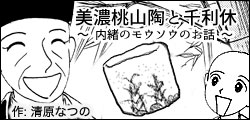








- 美濃の窯 ▽
Kilns Used to Fire Mino Ware - 美濃桃山陶 ▽
Momoyama-period Mino Ware -
可児市収蔵品
Kani Collections -
美濃焼の基本作陶法[video]
Basic work pottery method of Mino -
戦国武将と茶陶 ▽
Warlords and Tea Utensils-
織田信長の名物狩りと茶の湯御政道
ODA Nobunaga’s Gathering of Famous Tea Utensils and the Politics of Tea -
美濃金山城主森家と茶の湯
The MORI Family, Lords of Mino-Kaneyama Castle, and their Involvement with the Tea Ceremony -
豊臣秀吉と北野大茶湯
TOYOTOMI Hideyoshi and the Kitano Grand Tea Ceremony -
千利休と戦国武将
SEN no Rikyū and Warlords -
古田織部と茶陶
FURUTA Oribe and Ceramic Utensils for the Tea Ceremony
-
織田信長の名物狩りと茶の湯御政道
-
荒川豊蔵
ARAKAWA Toyozō -
加藤孝造
KATŌ Kōzō -
可児市の作陶家
Potters of kani city
企画のご案内
発掘調査
・発掘調査報告[6件]
 美濃桃山陶は、今から400年以上前の安土桃山時代に現在の岐阜県可児市をはじめとする東濃地方で、一斉に花を咲かせました。しかし長い間、愛知県の瀬戸市で焼かれたものと考えられ、「黄瀬戸」や「瀬戸黒」と呼ぶ名称にその名残があります。本当の産地がわかったのは、昭和5年(1930)荒川豊蔵が、可児市久々利大萱の牟田洞で志野筍絵の陶片を発見したことによります。
美濃桃山陶は、今から400年以上前の安土桃山時代に現在の岐阜県可児市をはじめとする東濃地方で、一斉に花を咲かせました。しかし長い間、愛知県の瀬戸市で焼かれたものと考えられ、「黄瀬戸」や「瀬戸黒」と呼ぶ名称にその名残があります。本当の産地がわかったのは、昭和5年(1930)荒川豊蔵が、可児市久々利大萱の牟田洞で志野筍絵の陶片を発見したことによります。美濃桃山陶の特色は、文様や釉薬により、豊かな色彩が施されたことです。当時、唯一美濃桃山陶だけがなしえた最新の技術でした。そのうえ使う側の好みを取り入れたので、折から盛んになった茶の湯の陶器として人気を博しました。
「黄瀬戸」は、黄色の地に花文様などを刻み、緑や茶(鉄釉)をアクセントのようにつけた上品なやきものです。「瀬戸黒」は漆黒の茶碗を主とします。この真っ黒な色は、窯から取り出して急冷することで生み出されました。「侘び」の茶碗の典型です。
「志野」は、真っ白な肌(長石釉)に鉄釉で下絵を描いたものです。日本のやきもので絹のような白い釉薬をかけたのは、「志野」が初めてです。筆によって自由に下絵を描いたのも初めてです。
全面に鉄釉を掛け、絵柄を削り出し、胎土の白さを浮かび上がらせる掻き落としの技法により白と茶を反転させたのが、「鼠志野」です。
「織部」は、新たに緑色などを加えたやきものです。「黄瀬戸」以来のすべての色彩を総合し、京の都で流行る文様をも巧みに取り入れました。「織部」からは、桃山文化の生き生きとした「造形の心」が浮かび上がってきます。
Momoyama-period Mino ware was produced more than 400 years ago, flourishing in the eastern part of Mino Province, particularly around what is now Kani City in Gifu Prefecture. However, for a long time, it was believed that these works had been fired in Seto district of Aichi Prefecture, which explains why the word ‘seto’ appears in the names of the ‘Kiseto’ [yellow Seto] and ‘Setoguro’ [black Seto] styles of Mino ware. The truth of their origins remained unknown until 1930 when the potter, ARAKAWA Toyozō, excavated a shard of Shino ware decorated with a bamboo shoot motif from the site of an ancient kiln at Mutabora in Kukuri Ōgaya, Kani City.
Momoyama-period Mino ware is characterized by the rich coloring displayed in its motifs and glazes. At the time, it represented the very latest in potting technique that was only achieved by the potters of Momoyama-period Mino. These potters catered to the tastes of the users when producing ceramic utensils for the tea ceremony, which was reaching the peak of its popularity at around this time.
Kiseto ware is a refined style of pottery, decorated with floral motifs, etc. that have been engraved in the body below a yellow glaze, before accents are added using green or brown (iron glaze). Setoguro ware mainly refers to tea bowls with a jet-black glaze. This black is achieved by removing the work from the kiln mid-firing and cooling it rapidly. These tea bowls are typical of the subdued taste known in Japanese as ‘wabi’.
Shino ware employs a pure white feldspar glaze with an underglaze motif applied using iron oxide. Shino ware was the first pottery in Japan to employ a pure white glaze, resembling silk. The freehand motifs were applied using a brush.
A scraping technique was utilized to create works with a pattern in white and brown that are known as Nezumi-shino (mouse-grey-shino) ware. First an iron glaze is applied over the entire surface, then the areas around the pattern are scraped away, allowing the white of the clay to show through.
Oribe ware introduced a green glaze to the decoration. It combined all the colors employed after Kiseto, while skillfully adding the patterns that were popular in Kyōto at the time. Oribe ware embodies the vivid beauty of form that was so typical of the Momoyama period.
Momoyama-period Mino ware is characterized by the rich coloring displayed in its motifs and glazes. At the time, it represented the very latest in potting technique that was only achieved by the potters of Momoyama-period Mino. These potters catered to the tastes of the users when producing ceramic utensils for the tea ceremony, which was reaching the peak of its popularity at around this time.
Kiseto ware is a refined style of pottery, decorated with floral motifs, etc. that have been engraved in the body below a yellow glaze, before accents are added using green or brown (iron glaze). Setoguro ware mainly refers to tea bowls with a jet-black glaze. This black is achieved by removing the work from the kiln mid-firing and cooling it rapidly. These tea bowls are typical of the subdued taste known in Japanese as ‘wabi’.
Shino ware employs a pure white feldspar glaze with an underglaze motif applied using iron oxide. Shino ware was the first pottery in Japan to employ a pure white glaze, resembling silk. The freehand motifs were applied using a brush.
A scraping technique was utilized to create works with a pattern in white and brown that are known as Nezumi-shino (mouse-grey-shino) ware. First an iron glaze is applied over the entire surface, then the areas around the pattern are scraped away, allowing the white of the clay to show through.
Oribe ware introduced a green glaze to the decoration. It combined all the colors employed after Kiseto, while skillfully adding the patterns that were popular in Kyōto at the time. Oribe ware embodies the vivid beauty of form that was so typical of the Momoyama period.
美濃桃山陶を所蔵している美術館・博物館(外部サイトへリンク)
